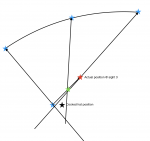Uricanejack
Well-Known Member
So if you assume you are closer to the danger, than the cocked hat assumes you are, what do you do?
Exactly the same thing, you avoid the danger by sailing away from it.
It isn't mathematics, its common sense.
If you were blindfolded & placed near the cliff edge at Beachy Head, would it matter if you didn't know exactly how close to the edge you were?
Of course not, no-one with any sense would walk toward it, the distance, regardless of accuracy is academic, you get away from the danger until you are safe, then reassess.
Common sense is reasonable.
Someone stated it was wrong, You asked why
The why is probability?
With a simple cross, off 2 position lines, including the actual X marks spot. there are 5 equally likely spots which might be your true position.
Add another position line.
You now have 3 times as many equally likely possibilities.

